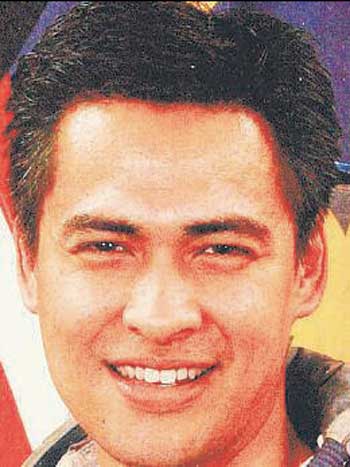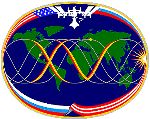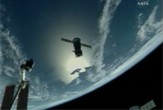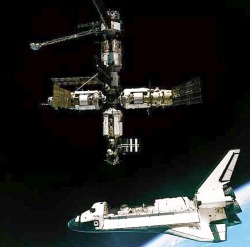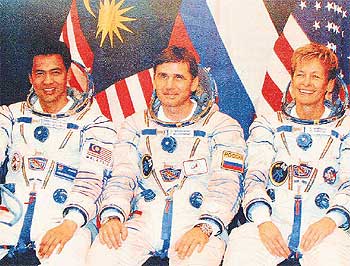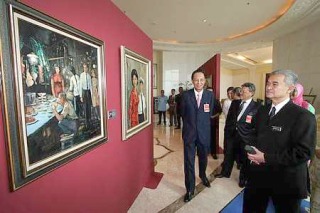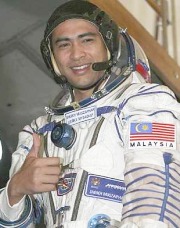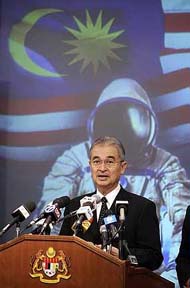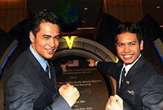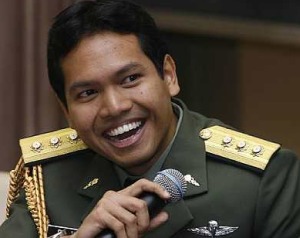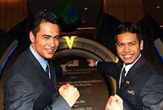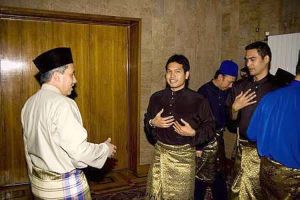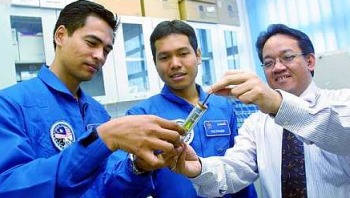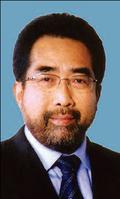Topic: - Editorials (Tributes)
|
Dr Sheikh Muszaphar Shukor Sheikh Mustapha, 35, is in the first team for the Oct 10 mission. Captain Dr Faiz Khaleed, 27, is the other Malaysian on standby. |
IN the 1960s, President John F. Kennedy poured millions of dollars into funding a space programme to land the first man on the Moon by 1970.
In his famous words: "I believe that this nation should commit itself to achieving the goal, before this decade is out, of landing a man on the Moon and returning him safely to Earth."
It was the Cold War and the Soviet Union, which launched its first satellite, the Sputnik, into space in 1957, and the United States were involved in an intense space race.
And the world followed closely the proxy race between the two nations to prove scientific superiority and military might.
The Soviet Union seemed to be ahead, and Yuri Gagarin became the first human in space and the first to orbit the Earth in April 1961.
But on July 21, 1969, Neil Armstrong became the first man to set foot on the lunar surface in the Sea of Tranquility, and his immortal words were:
"That's one small step for man, one giant leap for mankind."
An estimated 450 million global audience heard it live, indirectly declaring the US as the clear winner in the exploration of space.
The lunar landing was such an unusual feat that this great moment in science was doubted by sceptics. Some even called it a hoax, claiming that the National Aeronautics and Space Administration had faked the entire Apollo Moon project by filming it in a movie studio.
According to a 1995 Time Poll and a 1999 Gallop Poll, about six per cent of Americans did not believe that astronauts had walked on the Moon.
The moon walk ignited the interest of other nations in space exploration.
To quote Kennedy again: "...the dramatic achievements in space which occurred in recent weeks should have made clear to us all, as did the Sputnik in 1957, the impact of this adventure on the minds of men everywhere..."
So, too, is the case for Malaysia.
Quite aptly, after 50 years of independence, the country is to witness the blastoff of its first angkasawan to the International Space Station on Oct 10.
Two Malaysian astronauts are now at the Baikonur Cosmodrome in Kazakhstan to undergo final training before the launch.
The prime minister had said Malaysia is very proud that the Main Crew Commissioning Board has acknowledged that both the Malaysian astronaut candidates have passed with distinction and are qualified to represent the country in its first mission to space.
"This means that the country has two candidates who can join a space mission at any time when needed and have been accorded recognition by an international astronaut training body," Bernama quoted the prime minister on Sept 24.
The programme to send a Malaysian into space was conceived in 2003 when Russia (one of the republics of the former Soviet Union) agreed to send a Malaysian to the International Space Station as part of Malaysia's RM3.4 billion purchase of 18 Russian-made Sukhoi 30-MKM jet fighters.
However, unlike the space race of before which was an extension of the Cold War, today many nations are jointly involved in space projects, like the International Space Station.
What had started as an intense competition during the Cold War is today seen as partnership, and enmity has been replaced with friendship.
This mirrors very much what Malaysia hopes to achieve, namely firing the minds of even more of its citizens towards peace, while catapulting them into an imaginative orbit of their own.
Jim Burke, a retired Nasa expert working at the International Space University at Strasbourg, France, recently floated the idea of a "space-age Noah's Ark". This idea seeks to have backups of Earth's biological heritage and diversity in a permanently manned lunar facility.
In the event of a global catastrophe, the Ark will serve to reintroduce lost technology, art, history, crops, livestock and, if necessary, even human beings to Earth, according to a report in National Geographic News (Aug 14).
This is not such a far-fetched idea considering that famed scientist Stephen Hawking had warned that life on Earth could soon be wiped out by global warming or nuclear war.
"It is important for the human race to spread out into space for survival of the species," Time (June 26, 2006) cited him as saying.
In this regard, scientists hope to establish a massive library of human civilisation on the moon to protect against the wholesale loss of human achievement in the event that humankind is wiped out on Earth following a cataclysmic chaos.
After all, in the words of the 1937 Nobel Prize winner in Medicine, Albert Szent-Gyorgyi: "The Apollo flights demand that the word 'impossible' be struck from the scientific dictionary. They are the greatest encouragement for the human spirit.".
Source: The New Straits Times Online

